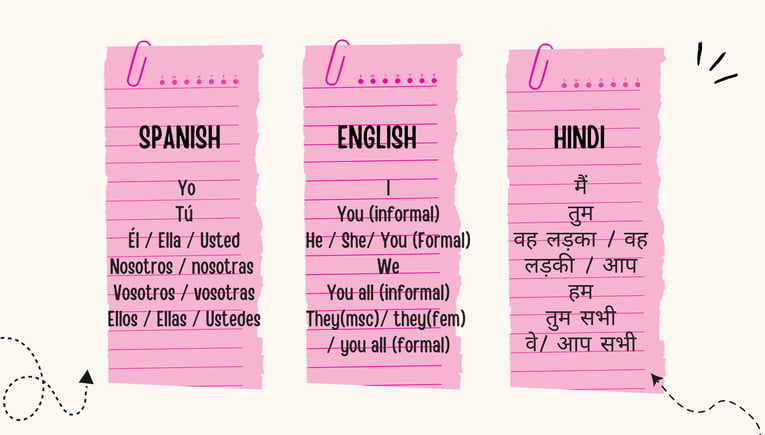START YOUR SPANISH LEARNING JOURNEY
PRONOUNS IN SPANISH - LOS PRONOMBRES
A pronoun is a word that replaces a nouns or names by being a substitute of a noun to avoid repetition.
12/22/20244 min read
Pronouns (los pronombres) in Spanish is a word that takes place of a noun or names, when a topic is established while telling a story. You don’t want to say or repeat the same word (nouns or names) over and over again and to avoid repetition you can use pronouns (pronombres) so that it wouldn't sound cluttered and boring.
Now let's take a look at this paragraph with pronouns to understand better.
Aarvi went to the market. Aarvi bought some vegetables. Aarvi will prepare a wonderful dish for her kids.
In the above paragraph Aarvi is repeated again & again and it makes the sentence cluttered. To make a paragraph seem more clear pronouns are used.
Let's take a look at this same story with pronouns-
Aarvi went to the market and she bought some vegetables. She will prepare a wonderful dish for her kids.
Now you see, how important pronouns are! They make a paragraph seem concise and clear.
Spanish pronouns can be used to -
Pronouns can be used in place of objects, subjects or indirect objects.
Pronouns have to be changed according to the gender or number (plurality) of a noun.
Pronouns demonstrates formality or shows respect in Spanish language.
When a subject is in position, pronouns are left out.
Pronouns tells us what something belongs to.
When we talk about direct or indirect objects, we place Pronouns before a verb.
Pronouns can help us in identifying unspecified person or thing.
Pronouns can also be used when you want to point something out.
Spanish Pronouns (Los pronombres en español) consists of :-
Los pronombres personales (Personal pronoun) - Subject and object
Subject pronouns - in a sentence subject is replaced. (for eg. She study (Ella estudia)
Object pronouns - Direct object pronouns (objeto directo) - in a sentence the direct object is replaced. For eg. He(subject) throws the ball(direct object) will become (He throws it.)
Indirect object (objeto indirecto) - in a sentence the indirect object is replaced. For eg. aarvi gives the book(direct object) to sakshi(indirect object).
Possessive pronouns (Pronombres posesivos) - they replace the things owned by someone. For eg. This dress is mine. (यह पोशाक मेरी है)
Prepositional Object pronouns (pronombre después de preposiciones) - pronoun is placed after a preposition. For eg. Play with(preposition) me(pronoun).
Reflexive pronouns (pronombres reflexivos) - when the action is done to oneself. For eg. He sent himself an email.
Relative pronoun (pronombre relativo) (used to relate a noun to another, i.e., “…the people who I met.
Indefinite pronoun (pronombre indefinido) replaces a non-specific entity. for eg…anything that you want.}
Demonstrative pronoun (Pronombre demonstrativo) makes a reference to something. For eg. “this and that”.
Luckily for us, while reading or listening to different types of Spanish pronouns we can figure out they are closely related. On the other hand, you will see that one letter or an accent mark (tilde) can completely change the meaning of a word, and while reading or writing this can change the relatedness of the sentence.
Exposing yourself to listening or reading Spanish pronouns is crucial to get a hang of the Spanish pronouns especially (indirect pronouns) pronombres indirecto as they are placed before the verbs (verbos). In Spanish language, pronouns are used differently than in English, so it is important to listen to native speakers to see how they use it.


Personal Pronouns - Los Pronombres Personales
There are two types of personal pronouns - Subject (sujeto) and object (objeto).
Subject Pronouns
In Subject pronouns, the noun or name or thing is the main subject that is doing or being something. You have to conjugate your verb (action) to match with the subject (person, place or, thing). The different types of subject pronouns in Spanish are the same as English or Hindi.
In Spanish subject pronouns -
First person singular is Yo (I, मैं).
Second person singular is Tú (You informal/तुम) Usted (you formal/ आप). But the conjugation of usted is same as él/ella (he/she).
Third person singular is él/ella ( he वह लड़का / she वह लड़की).
The accent marks on Tú & él is crucial as without it the meaning of the word is different tu(your) and el(the).
First person plural is Nosotros (We masc.) and Nosotras (We fem.) हम.
Second person plural Vosotros (You all masc informal) Vosotras (You all fem) तुम सभी / ustedes (you all formal) आप सभी.
Third person plural is Ellos / Ellas ( They all वे सभी )
Just as in English, the pronouns he/she denotes the gender, Spanish pronouns are also changed according to the person you're talking of. Plural spanish pronouns (We) Nosotros/Nosotras, (you all) Vosotros / Vosotras, (They all) Ellos / Ellas need to be changed to match the gender of the group of people, place or things.
As long as the context of spanish object pronouns is clear in your mind, you can now skip them while speaking because the verb you conjugate mostly denote who you're referring to. In most of the cases, the Spanish verb conjugations shows us who it is referring to. Let's compare with English in which the verb only change in the third person singular (I eat, you eat, he/she eats/ we eat/ you all eat/they all eat) this in spanish will be (yo como, tú comes, él /ella/ usted come, Nosotros/as comemos , Vosotros/as comais, Ellos/Ellas/Ustedes comen). The verbs are conjugated in this sentence according to the pronoun which tells us who we're talking about.
Now that you've learnt the Spanish subject pronouns, stay tuned for all of the other pronouns.
